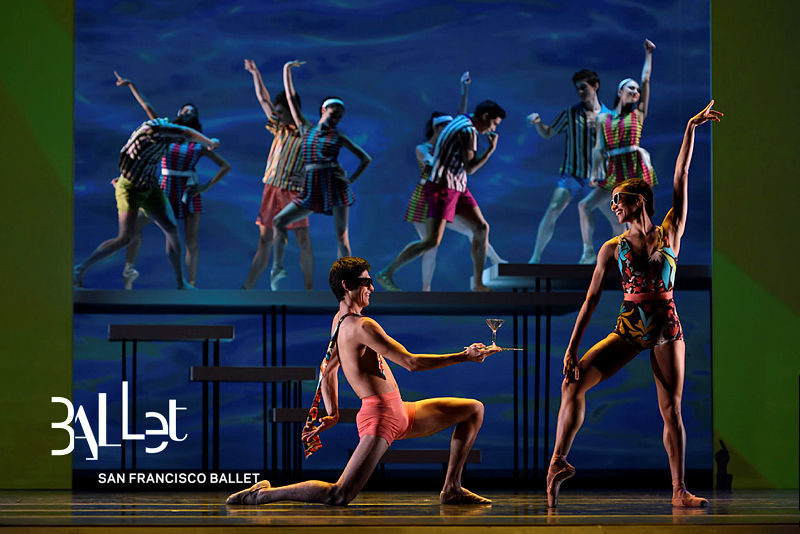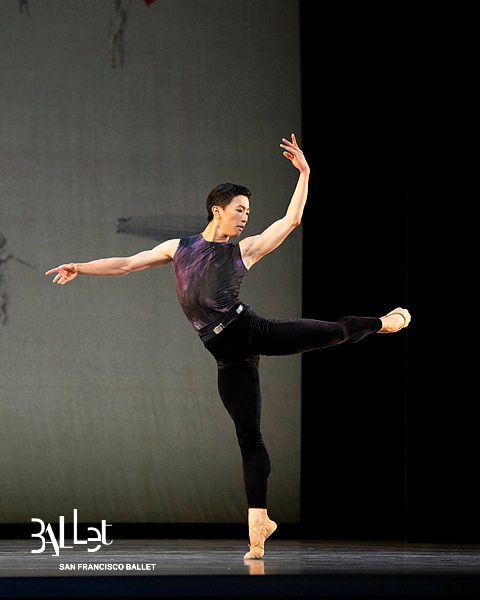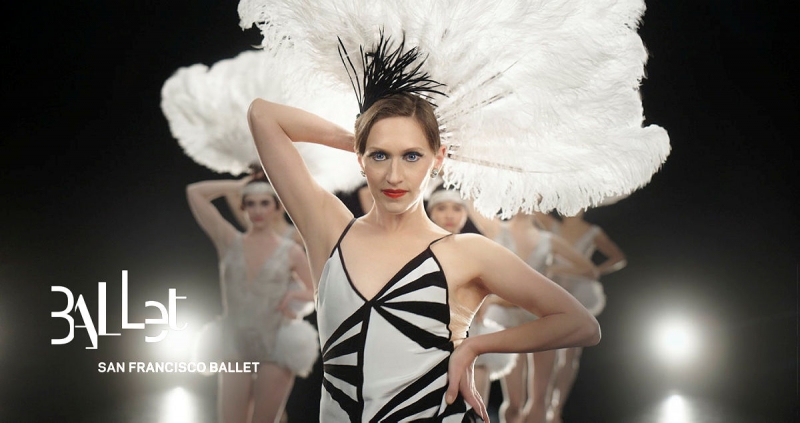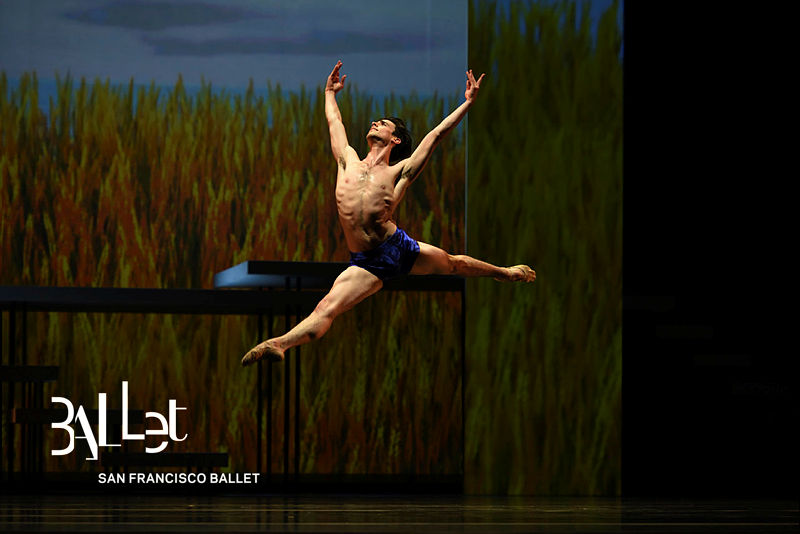Review: PROGRAM 03 at San Francisco Ballet Delivers Terrific Performances in Some Striking Ballets
The latest program in the company's 2021 digital season is available for streaming through March 24th

Sean Bennett and Kimberly Marie Olivier in foreground
(photo by Erik Tomasson)
There is a lot to love in San Francisco Ballet's recently unveiled Program 03 of mixed repertoire, even if it takes a bit of a dip in the middle. The program gets off to a smashing start with Alexei Ratmansky's Symphony #9, which is part of his justly celebrated Shostakovich Trilogy. SFB veritably bursts onto the stage in the lightning-quick first movement that is at once joyous, bumptious, impish and a little off kilter. Just when you think you know where it's going - oops! - it turns on a dime and heads in a completely different direction. The overall jaunty tone is encapsulated in a repeated move where the ever-astonishing Joseph Walsh takes an impetuous sideways leap into the arms of the four men to his right, landing gracefully while managing to keep his entire body facing audience-front the whole time.

Max Cauthorn, Benjamin Freemantle and Lonnie Weeks aloft in foreground
(photo by Erik Tomasson)
The middle section of the ballet at first appears to be a fairly standard romantic adagio until you notice that the central couple (a beautifully in-synch Aaron Robison and Jennifer Stahl) almost never lock eyes, but instead keep looking furtively over their shoulders as if they are being followed by some kind of menacing presence. It is then that you start to discern the growing, underlying militarism in the fife and drum instrumentation. By the final section, once again wildly uptempo, what had initially seemed merely frolicsome now feels bombastic. The ballet comes to a climax with the full company onstage in a rush of quasi-military brio before ending with a solo dancer spinning alone in the darkness.

(photo by Erik Tomasson)
Ratmansky's choreography is attentive to the shifting moods and modes of Shostakovich's complicated score, and the dancers attack the movement with relish, cleanly articulating each surprising twist and turn. A standout in the cast of 21 is Wei Wang, who often enters a sequence midway through as a sort of ambiguous presence insinuating himself between the couples, and in the end brings the ballet to its thrilling conclusion. The verticality and speed of his spins is nicely complimented by the serenity and grace he shows in the slower middle section. We are also fortunate that the ballet was captured in a May 2019 performance stacked with some of SFB's best dancers in even the smaller roles. What a pleasure it is to dancers of the caliber of Lonnie Weeks, Benjamin Freemantle, Max Cauthorn and Julia Rowe, each bringing their own distinctive style to the piece. All in all, a terrific opener, and one that benefits from the multiple viewings that are possible with a digital presentation.
The second ballet on the program is Wooden Dimes, a world premiere narrative dance film by Danielle Rowe. It has a promising Funny Girl-inspired opening before gradually descending into cliché and tedium. I certainly admire Rowe's ambition in making a narrative ballet, as they are notoriously tricky to pull off. And who better than Sarah Van Patten to star in it? Van Patten has long been SFB's top dramatic ballerina, with an uncanny ability to create fully-realized portraits of a wide variety of characters without ever skimping on the fiendishly difficult technical demands of classical ballet. Plus, there is something just so intrinsically fascinating about her stage persona. She always seems to have such a rich interior life that she naturally draws you in.

(photo courtesy of San Francisco Ballet)
Wooden Dimes is set in the world of 1920's vaudeville, where Van Patten dances in the chorus before being plucked for stardom. Along the way, she deals with a lecherous boss, her marriage suffers, and various demons for husband and wife arise. At least I think that's what happens - I will admit that I found the narrative logic to be more than a little shaky. Rowe conceived the ballet specifically for film from the beginning and utilizes the medium to create effects that would not be possible onstage. There are jump cuts and swooping pans, and camera angles are often from on high, including a Busby Berkeley-esque sequence with chorus girls waving ostrich-feather fans in geometric patterns. The film has a distinctive look with the dancers and scenic elements isolated against a flat black void of a background. Unfortunately, that stark design choice creates an overriding air of claustrophobia and also allows us to see that the Busby Berkeley movements are a little sloppily executed.
Through it all, Van Patten gives it her considerable best. She moves well and photographs beautifully, but ultimately can't rise above the lackluster material. I was left feeling like Rowe had a lot of ideas, some of them potentially valid, but was unable to translate them into an effective ballet. It was never clear to me why she had chosen to tell this particular story in this particular fashion. Rowe served as both choreographer and director of the film. Perhaps she would have benefitted from having a collaborator on one or both of those roles?
Program 03 gets markedly back on track with its closing ballet, Yuri Possokhov's thrilling Swimmer, inspired by a John Cheever short story that is basically an allegory about the hollow core of the American Dream. Possokhov takes certain liberties with his source material, but it remains the story of a family man who swims his way home through his neighbors' pools. As is often the case with Possokhov's ballets, the choreography is often effectively incisive and stylized while occasionally going a bit slack and indistinct, and the visual elements are striking and audacious throughout. His concept employs a wildly effective combination of animation, video, still projections, lighted scrims and 3-D set pieces to create an ever-shifting reality that takes us from generic suburbia to a progression of swimming pools and eventually to the open sea. There are stops along the way at many major American cultural touchstones of the 20th century, such as Mike Nichols' film of The Graduate and Edward Hopper's iconic "Nighthawks" painting. Possokhov tacks on an ending of his own invention that somehow manages to be choreographically thrilling, vaguely life-affirming and deeply unsettling all at once.

(photo courtesy of Erik Tomasson)
Aside from the staggering visuals, the big story here is Joseph Walsh's astonishing performance in the leading role. It is incredibly demanding in the intensity and amount of stage time required as he transitions from the everybusinessman at the beginning to the eternally searching swimmer who meets his ultimate fate. Walsh uses his technical brilliance and emotional transparency to create a character who is both empathetic and haunted. Along the way, he is aided and abetted by some terrific performances by others in the cast, including Lauren Strongin as a coquettish Lolita type, and the trio of Max Cauthorn, Daniel Deivison-Oliveira and Pascal Molat (in place of James Sofranko, as listed in the credits) - three airborne dervishes who lead the ballet's penultimate section and propel it to its stirring and unnerving conclusion with a lone Walsh swimming off into eternity.
Program 03 of San Francisco Ballet's digital season is available for streaming through March 24, 2021. For further information and to purchase tickets, visit www.sfballet.org or call (415)865-2000.
Reader Reviews
Videos

